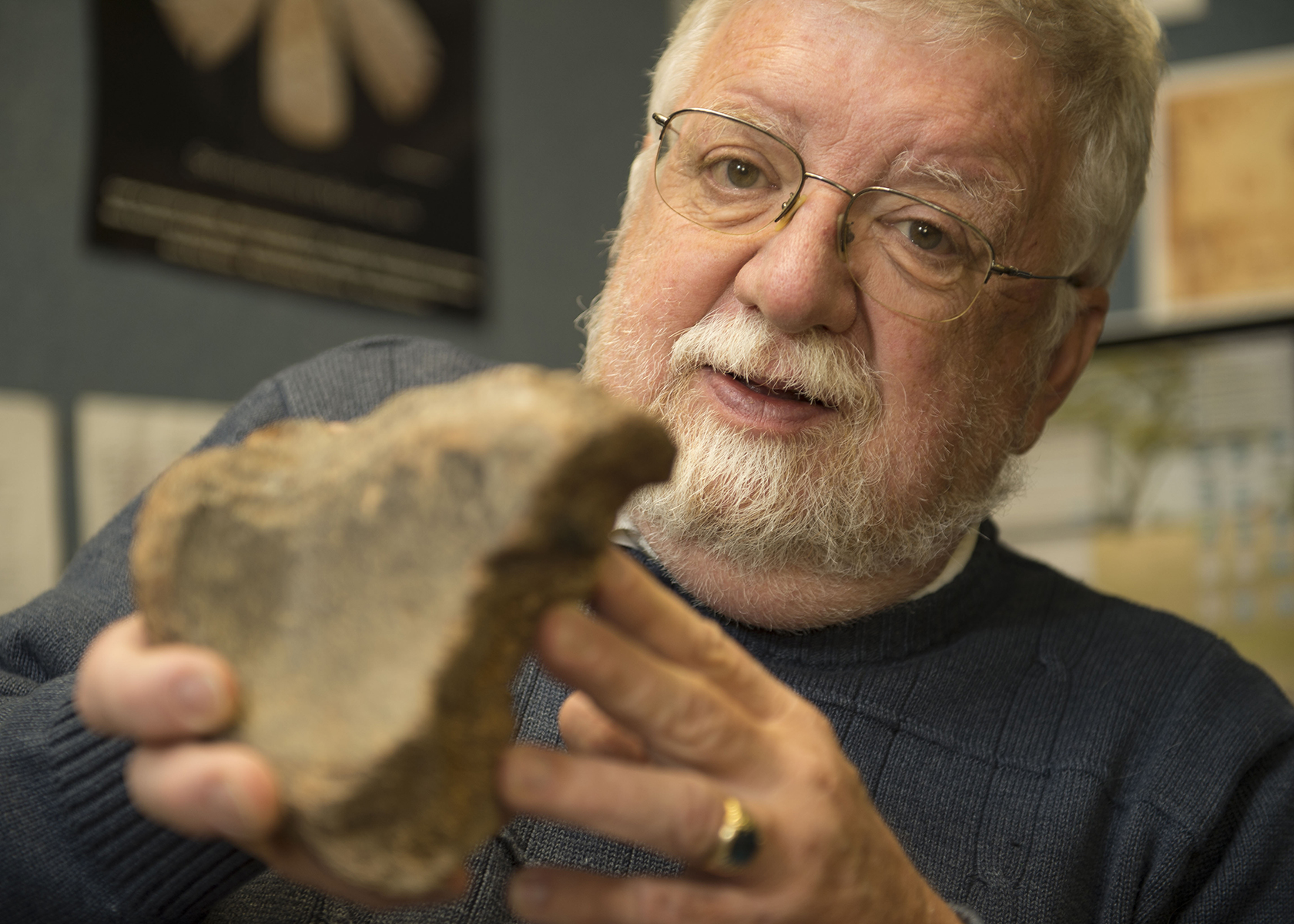
Mark Wagner, director of the Center for Archaeological Investigations at Southern Illinois University Carbondale, holds the only mastodon bone known to be collected in Jackson County, Ill. The bone is a fraction of the lower part of the tibia, near where the leg connects to the foot. The bone is approximately 15,000 years old. (Photo by Russell Bailey)
February 05, 2016
Artifact collection includes rare mastodon bone
CARBONDALE, Ill. – It’s one of those “you can’t easily mistake it for something else” kinds of finds. But when it’s the only one ever recorded in Jackson County, Ill., it’s almost hard to believe it’s a mastodon bone.
Mark Wagner, director of the Center for Archaeological Investigations at Southern Illinois University Carbondale, said the university received the bone as part of a large collection donated last summer by brothers Mike and Don Porter from Murphysboro. Their father, Henry, was a private collector of artifacts. He did most of his collecting in the 1950s and ‘60s, mostly on private land sites in Southern Illinois. Unlike many who are merely treasure-seekers, Porter recorded his artifact sites in detail. In this case, the site was a rock shelter on private property, and the bone was six feet below the surface.
The mastodon bone is the lower part of the tibia, or shin bone, and is approximately eight inches long. Porter found it in a natural rock shelter of the type frequently used by native residents of the area. It was the only mastodon bone found at the site, and indeed the only one ever recorded in Jackson County.
“We know the mastodon didn’t get itself up inside a rock shelter,” Wagner said. “It may have got there by way of human agency.”
First, Wagner needed to date the bone. If it were no older than about 10,000 B.C., when the first people came into what is now Illinois, then it might have been possible human hunters killed the mastodon and brought its carcass to the rock shelter. Older than that, and the mastodon died before Homo sapiens were present.
Chris Widga, a vertebrate paleontologist and associate curator of geology at The Illinois State Museum Research and Collections Center, conducted the dating tests on the bone. Widga was recently investigating extinction patterns in mammoths and mastodons. He finished the dating tests on the Jackson County bone in late November and determined the bone is about 15,000 years old. That’s about 1,500 years before the first people were in Illinois.
“So, we are left with the question of how it got into the rock shelter,” Wagner said. “It had either to have been drug in by animals or found by later Native Americans and brought there. I tend to think the second scenario is more likely.”
There isn’t anything on the bone itself to give a clue about how it got into the rock shelter. There aren’t cuts or carvings or burn marks that might indicate if the bone had a particular function.
Mastodons were widely distributed in the Midwest until the end of the Pleistocene epoch, about 11,500 years ago. Widga wrote in his blog, “Backyard Paleo,” that when they become extinct, “mastodons go out with a bang.” He recently concluded a four-year, National Science Foundation-funded investigation of mammoth and mastodon extinction in the Midwest. Mammoth and mastodon extinction dates to the end of the last Ice Age, and is one of a handful of major mass extinctions dating back into pre-history. The extinction event occurred at about the same time as major climate change (the end of the Ice Age) and the introduction of the first Homo sapiens.
The Jackson County mastodon tibia bone is one of many mastodon bones in museums around the Midwest. Wagner noted that mastodons were more common in the southeast of Illinois than in the southwest because of the presence of salt springs there. However, early settlers processed salt near sites along the Big Muddy River, so salt availability alone doesn’t necessarily account for the paucity of mastodon artifacts in the southwest of Illinois.
There might, in fact, be more mastodon bones in Jackson County either as yet undiscovered or in private collections. As Wagner noted, without the Porter family donation, there would be no record of this one.
The Henry Porter collection numbers more than 10,000 artifacts, including arrowheads, axes, pottery shards and other items, all of which were collected in Jackson County. It is now part of the permanent artifact collection housed at the Center for Archaeological Investigations curation facility.
